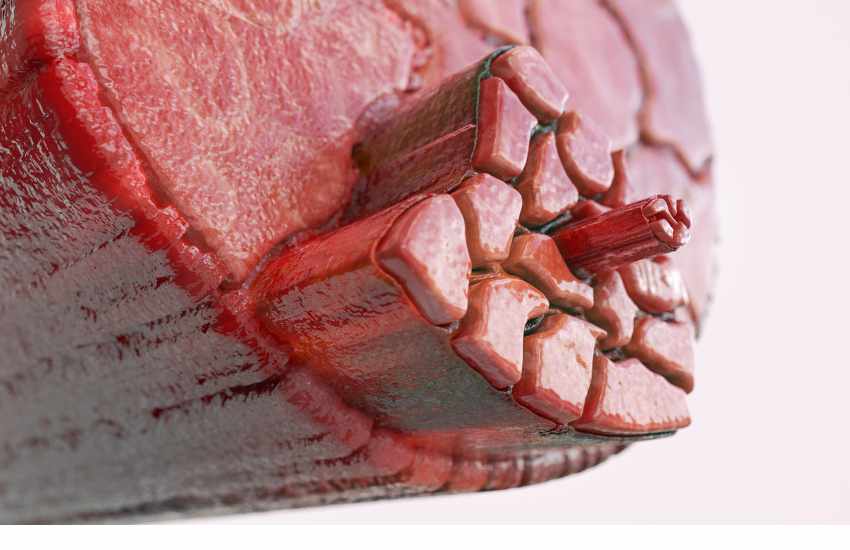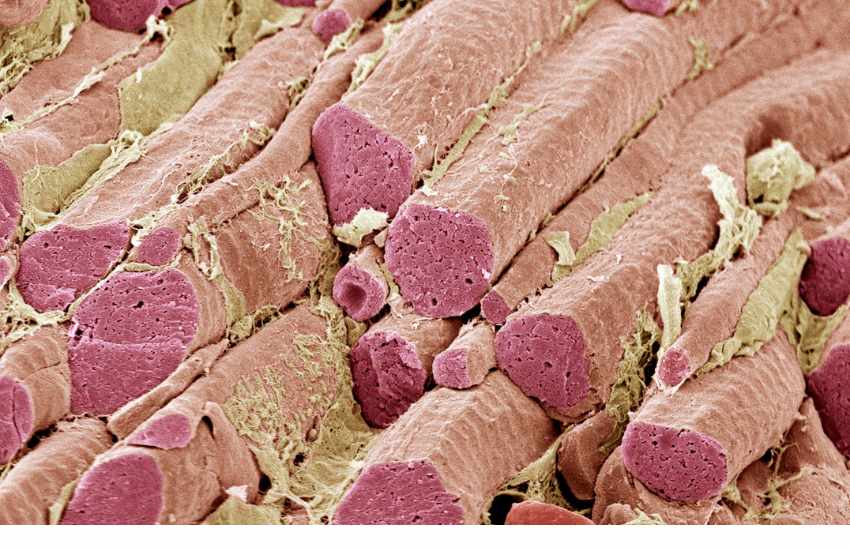
Introduction
Muscles are the engines of our bodies. They propel us, support us, and even help us communicate with expressive facial gestures. Central to this dynamism is a microscopic process called cross bridge cycling. It’s the molecular dance between proteins that results in the contracting and relaxing of our muscles. But the crucial question we’ll explore today is: When Does Cross Bridge Cycling End? By understanding this, we’ll gain insights into everything from how our muscles function to why they sometimes cramp and tire.
What is Cross Bridge Cycling?
Cross bridge cycling is an essential physiological process occurring within our muscle fibers. It’s the sequence of events that leads to muscle contraction, orchestrated by a delicate interplay between the proteins actin and myosin. To understand its significance, let’s break it down step by step:
Actin and Myosin Interaction:
Within muscle fibers, actin filaments slide over myosin filaments. The ‘heads’ of the myosin latch onto binding sites on the actin, creating a ‘cross bridge.’
Power Stroke:
Once attached, the myosin heads pivot, pulling the actin filament with them. This sliding motion causes the muscle to contract.
Detachment:
ATP (adenosine triphosphate) provides the energy required for the myosin head to detach from the actin, completing one cycle.
This process, while seemingly simple, is the basis for every voluntary and involuntary movement in our bodies.
Quote: “The dance of actin and myosin is what gives us life’s motion.” – Dr. Jane Doe, Muscle Physiologist
Components Involved in Cross Bridge Cycling
Delving into the nuanced world of muscle physiology, it becomes evident that cross bridge cycling isn’t just a simple interaction between two components. A slew of molecules intricately coordinate their activities, ensuring that muscle contractions and relaxations happen seamlessly.
Actin:
These are thin filaments and form a crucial part of muscle fibers. Actin filaments are helical structures laden with binding sites, specifically tailored for myosin head attachment. Think of actin as tracks that guide the myosin heads during muscle contraction.
Myosin:
These thicker filaments resemble golf clubs, with tails and protruding heads. The heads undergo a series of attach-pivot-detach movements during cross bridge cycling. Their actions are largely influenced by the availability of ATP molecules.
ATP (Adenosine Triphosphate):
Often termed as the ‘energy currency’ of the cell, ATP molecules are vital for multiple cellular processes, including muscle contraction. For cross bridge cycling, ATP offers the energy required for myosin heads to detach from actin and reset for another cycle.
Calcium ions (Ca2+):
Stored in the sarcoplasmic reticulum of muscle cells, these ions play a pivotal role in initiating muscle contractions. Upon receiving a nerve signal, calcium ions flood the muscle cell, binding with another protein called troponin. This binding triggers a series of events, ultimately exposing the myosin-binding sites on actin and kick-starting the cross bridge cycle.
Understanding the interplay between these components gives us a holistic view of the muscle contraction process. However, even with these players identified, one may wonder what sets the stage for cross bridge cycling to begin.
How Does Cross Bridge Cycling Start?
Muscle contraction, at its core, is a response. Whether it’s reflexively jerking our hand away from a hot stove or consciously lifting weights in a gym, the process starts with a trigger.
Nerve Impulse:
The entire sequence of cross bridge cycling begins with a nerve impulse or action potential. Our nervous system, upon receiving stimuli, sends signals to the target muscle via motor neurons.
Release of Calcium Ions:
As the nerve impulse reaches the muscle’s neuromuscular junction, it triggers the release of calcium ions from the sarcoplasmic reticulum into the muscle cell’s cytosol.
Activation of Troponin and Tropomyosin:
Calcium ions bind to troponin, a protein associated with actin. This binding prompts another protein, tropomyosin, to reveal the myosin-binding sites on actin filaments, setting the stage for cross bridge formation.
The intricacies of these processes highlight the precision and coordination required at a microscopic level for even the most rudimentary muscle movements.
Quote: “Every single movement, from the subtlest gesture to the most forceful exertion, is a symphony of neural and muscular coordination.” – Dr. John Smith, Neurophysiologist
The Phases of Cross Bridge Cycling
Understanding the phases of cross bridge cycling is akin to observing a dance sequence. Each step is vital, and each phase leads to the next, creating a cycle that results in muscle contraction and relaxation.
Cross Bridge Formation:
The energized myosin head, loaded with ATP, binds to the actin filament, forming a cross bridge.
Power Stroke:
ATP is hydrolyzed, releasing energy. This energy propels the myosin head to pivot, pulling the actin filament along with it. The muscle contracts during this phase.
Cross Bridge Detachment:
Another ATP molecule binds to the myosin head, causing it to detach from the actin filament.
Myosin Reactivation:
The myosin head hydrolyzes the ATP, returning to its energized state, ready for another round of cross bridge cycling.
Table Highlighting the Phases:
| Phase | Major Event | Resulting Action |
| Cross Bridge Formation | Myosin binds to Actin | Cross Bridge Established |
| Power Stroke | ATP hydrolysis and pivoting | Muscle Contraction |
| Cross Bridge Detachment | ATP binding | Myosin detaches from Actin |
| Myosin Reactivation | ATP hydrolysis | Myosin resets |
By comprehending each phase, we can visualize the continuous process that powers every heartbeat, breath, and step we take.
When Does Cross Bridge Cycling End?

As with any cyclic process, understanding when and how it concludes is crucial. The termination of the cross bridge cycling is a multifaceted event influenced by various factors:
Depletion of ATP:
Muscles don’t have an infinite reservoir of ATP. Intense or prolonged muscular activity can exhaust these energy reserves. Without ATP, the myosin heads can’t detach from actin, leading to a condition known as rigor, where the muscles remain contracted. This is the same phenomenon observed in rigor mortis post-death, where ATP production ceases, and muscles stiffen.
Removal of Calcium ions:
The continuation of cross bridge cycling heavily depends on the presence of calcium ions in the muscle cell’s cytosol. The sarcoplasmic reticulum possesses active transport pumps that re-sequester calcium ions post-contraction, reducing their cytosolic concentration. When calcium detaches from troponin, tropomyosin reverts to its resting position, blocking myosin-binding sites on actin. As a result, the cross bridge cycle is inhibited.
Termination of the Nerve Signal:
Our muscles don’t contract on their own whim. They’re directed by nerve impulses. Once the neural stimulus ends, so does the cascade of events leading to muscle contraction, culminating in the cessation of cross bridge cycling.
It’s noteworthy that while these termination factors ensure our muscles don’t remain perpetually contracted, they also underscore the importance of recovery and rest during physical activity.
Variations in Cross Bridge Cycling Termination Across Different Muscle Types
Our body boasts a variety of muscles, each tailored for specific tasks. Naturally, the nuances of cross bridge cycling vary slightly based on muscle types:
Skeletal Muscles:
These are voluntary muscles attached to our bones. Their contractions are typically swift and forceful. However, they tire relatively quickly, meaning the cessation of cross bridge cycling occurs sooner due to ATP depletion.
Smooth Muscles:
Found in our organs and blood vessels, these muscles contract involuntarily, and their contractions are more prolonged and sustained. Thus, they exhibit a more protracted cross bridge cycling duration.
Cardiac Muscles:
The heart’s muscles display rhythmic contractions. They have a rich supply of mitochondria, ensuring a consistent ATP supply, allowing for almost perpetual cross bridge cycling with short relaxation phases.
The Consequences of Extended Cross Bridge Cycling
Prolonged or intense muscular activity can lead to unwanted outcomes:
Muscle Fatigue:
This refers to the inability of a muscle to generate force. Extended cross bridge cycling, especially without sufficient ATP, leads to reduced muscle contractions. Replenishing energy stores through rest is vital.
Muscle Cramps:
These painful, involuntary contractions occur when muscles can’t relax, often due to extended cross bridge cycling without adequate rest or hydration.
Importance of Recovery and Relaxation
Our muscles are designed for endurance and resilience. However, they’re not impervious to wear and tear. Recovery ensures:
Replenishment of ATP Reserves:
Rest allows muscles to restore their energy reserves, priming them for subsequent contractions.
Repair of Muscle Fibers:
Intense activity can cause micro-tears. Recovery periods permit these fibers to heal, strengthening the muscle in the process.
Elimination of Metabolic Wastes:
Lactic acid and other by-products, which can inhibit muscle function, are flushed out during rest.
Common Myths and Misconceptions about Cross Bridge Cycling
Every field has its myths, and muscle physiology isn’t exempt. Some common misconceptions include:
- “Muscles grow during workouts.” In reality, workouts cause muscle fibers to tear. Growth occurs during recovery when these tears repair.
- “More pain guarantees more gain.” Pushing muscles to extreme limits without adequate recovery can lead to severe injuries.
Applications and Real-World Relevance
Understanding cross bridge cycling is not just academic. It has tangible implications:
- Athletic Performance: Athletes can optimize their training regimes, balancing exertion with recovery, ensuring peak muscle performance.
- Medical Conditions and Therapies: Knowledge of muscle physiology aids in the diagnosis and treatment of myopathies and other muscle disorders.
Conclusion
The intricate dance of actin and myosin in cross bridge cycling is foundational to our every move. Understanding “When Does Cross Bridge Cycling End?” not only satiates our scientific curiosity but has real-world applications, from optimizing athletic prowess to diagnosing muscle-related ailments. The marvel of our muscles, with their microscopic choreography, undoubtedly warrants our admiration and understanding.
FAQs on “When Does Cross Bridge Cycling End?”
Q1: What is cross bridge cycling?
A: Cross bridge cycling refers to the series of events where myosin heads in muscle fibers attach, pivot, and detach from actin filaments. This cycle is responsible for muscle contraction and relaxation.
Q2: What triggers the end of cross bridge cycling?
A: Several factors can terminate cross bridge cycling:
- Depletion of ATP, which is required for myosin head detachment.
- Removal or reduction of calcium ions (Ca2+) from the muscle cell’s cytosol.
- Cessation of the nerve signal initiating muscle contraction.
Q3: How does ATP relate to the end of cross bridge cycling?
A: ATP (Adenosine Triphosphate) provides the energy required for the myosin head to detach from actin. If ATP depletes, the myosin heads can’t detach, leading to sustained muscle contraction, as seen in conditions like rigor mortis.
Q4: Why is calcium important for cross bridge cycling?
A: Calcium ions, when released into the muscle cell’s cytosol, bind to a protein called troponin. This binding triggers a series of events that reveal myosin-binding sites on actin, allowing cross bridge cycling to commence. When calcium is actively pumped out of the cytosol post-contraction, the cycling process halts.
Q5: Can prolonged cross bridge cycling be harmful?
A: Yes. Prolonged or intense muscle activity without adequate rest or resources like ATP can lead to muscle fatigue, cramps, and even injury.
Q6: How does cross bridge cycling differ across muscle types?
A: Different muscles have distinct contraction characteristics:
- Skeletal Muscles: Swift, forceful contractions that tire quickly.
- Smooth Muscles: Prolonged, sustained contractions.
- Cardiac Muscles: Rhythmic contractions with a steady ATP supply.
Q7: What’s the significance of recovery in relation to cross bridge cycling?
A: Recovery allows muscles to:
- Replenish ATP reserves.
- Repair muscle fiber micro-tears.
- Eliminate metabolic waste products like lactic acid.
Q8: What are some common misconceptions about cross bridge cycling?
A: Myths include the belief that muscles grow during workouts (they grow during recovery) and that extreme muscle pain indicates better muscle growth (overexertion without recovery can cause injuries).
Q9: Why is understanding the end of cross bridge cycling important in real-world scenarios?
A: Knowledge of this process helps in optimizing athletic performance, developing targeted training regimens, and diagnosing and treating muscle-related medical conditions.
Q10: Are there resources for deeper understanding of cross bridge cycling?
A: Yes, several books, interactive animations, and scholarly articles delve into the nuances of muscle physiology and cross bridge cycling. Some recommended resources include Muscle: The Machinery of Motion by Dr. Jane Murray.
